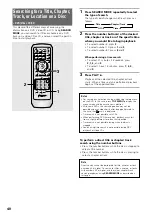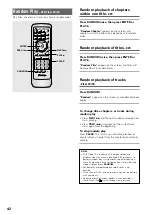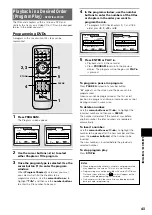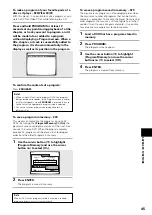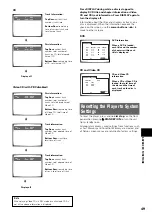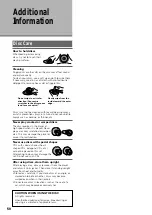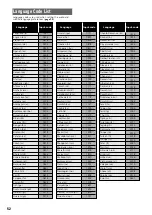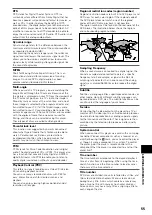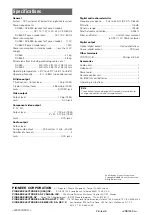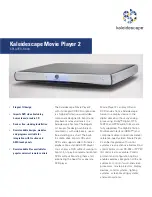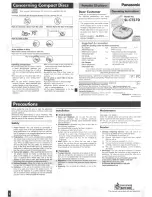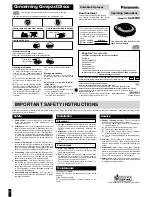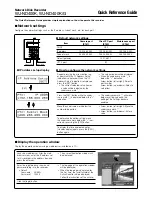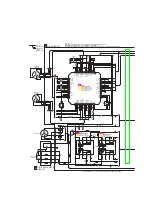
54
Audio is not output or is distorted.
The Setup screen
Audio 1
menu
[96 kHz PCM Out]
setting is set to
[96 kHz]
. Digital output is prohibited
on some discs.
\
Be sure to make analog audio connections as well
as digital connections (
page 14
).
The disc is dirty.
\
Refer to
‘Disc Care’
(
page 50
).
The connection plugs are not inserted fully into the
terminals or are not connected.
\
Check that all connection plugs are firmly inserted.
The connection plug or terminal is dirty.
\
Check that the plugs and terminals are wiped
clean of dirt, etc.
Audio cable connection is wrong.
\
Check to make sure that the audio cables are
connected correctly (
page 14
).
Connection is made to the stereo amplifier‘s PHONO
input terminal.
\
Change connection to any input terminal except
PHONO.
The pause mode is engaged.
\
Press
PLAY
3
or
PAUSE
8
to exit the pause
mode.
Stereo amplifier operation is incorrect.
\
Check input (CD, AUX, etc.) selector to determine
if it is selected for DVD playback.
The DVD or CD is recorded in DTS audio.
\
DTS audio is only output from the digital output
jacks. Connect the digital output on the player to
the digital input on a receiver or amplifier with a
built in DTS decoder to hear DTS audio.
Noticeable difference in DVD and CD volume.
DVDs and CDs use different recording methods.
\
This is not a malfunction.
There is a howling or high-pitched sound from the
speakers when using the karaoke function. (DV-535K
only)
The mic is too close or pointing towards the speakers.
\
Try to keep the mic pointed away from the
speakers.
\
Turn down the volume on the mic.
Karaoke functions are not possible. (DV-535K only)
A mic is not connected to the player or is not turned
on.
\
Check that a mic is connected to the player. If the
mic has an on/off switch, check that the mic is
switched on.
The mic volume is turned down all the way.
\
Adjust the mic volume so that vocals can be
heard.
Caution
Static electricity or other external influence may cause
malfunctioning of this unit. In this case, unplugging
the power cord and then re-plugging it in will usually
reset the unit for proper operation. If this does not
correct the problem, please consult your nearest
PIONEER service center.
Terms
Aspect ratio
Aspect ratio refers to the length to height ratio of TV
screens. The ratio of a standard TV is 4:3, while the ratio
of a high-definition or wide TV is 16:9. The latter allows
you to enjoy a picture with a wider perspective.
Chapter number
Chapter numbers are the numbers assigned to sections
of a title on the disc, similar to chapters in a book. If the
disc includes chapter numbers, you can locate the
section you want very quickly using search and other
functions.
Component (color difference) video output
The color signal of the TV is divided into the luminance
(Y) signal and the color (P
B
and P
R
) signals and then
output. In this way mutual interference of each signal is
avoided. On a TV with component input jacks, these
signals are synthesized to produce the picture.
Condition memory
“Condition” refers to the various mode settings, etc. On
this player, various conditions, such as those set during
playback, can be memorized. This function allows you to
play back the same disc at any time without having to
redo your preferred settings.
Digital bitstream
The bitstream does not refer to the audio signal, but
rather to the digital data that, once converted, becomes
the audio signal. The player outputs digital bitstreams via
the digital optical or digital coaxial output. If the
bitstream cannot be decoded by the connected AV
amplifier etc., digital noise is produced. Digital bitstream
formats compatible with different entertainment
systems can be selected in the Setup screen
Audio 1
menu.
Digital output (Coaxial)
Output of the digital audio signal is transmitted
electronically using a coaxial cable. Because the signal
being transmitted is digital, connection must be made to
the coaxial digital input of another component. Noise will
be output if connected to the analog audio inputs as the
digital signal cannot be decoded.
Digital output (Optical)
Normally, audio is converted to an electric signal and
transmitted through an electric wire from the player to
the amplifier, etc. Changing this signal to a digital signal
and transmitting it through an fiber-optic cable is called
optical digital output. Similarly, optical digital input
receives digital signals from external units such as an AV
amplifier or receiver.
Dolby Digital
The maximum 5.1 channels of audio used in the
surround system (Surround Digital) for movie theaters is
digital data compressed by the third generation algorithm
encoder.
In order to enjoy Dolby Digital discs, this unit’s digital
output jack (either coaxial or optical) must be connected
to the digital input jack of an AV amplifier or Dolby Digital
decoder to enjoy the sound of Dolby Digital soundtracks.
1

